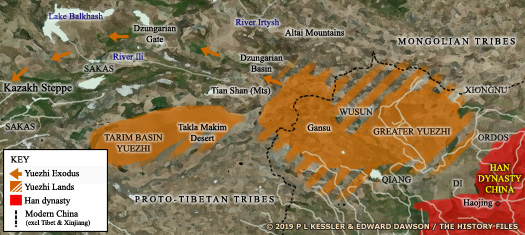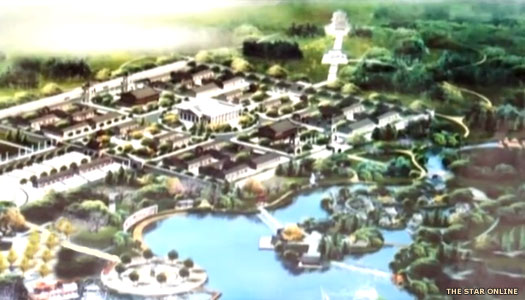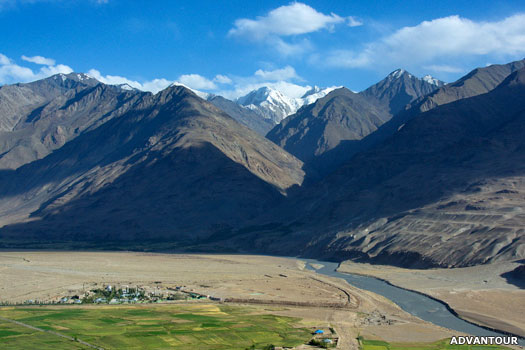
| WUSUN (TURKS) Wusun (Turks) :
The Wusun were a nomadic horse-riding steppe people who were prominent between China and Central Asia during the second century BC. They had an origin myth (albeit one which took place during their recorded existence instead of before it) which described the tribe being damaged by warfare and then taking refuge in the Altai Mountains until they had recovered. In essence it was a basic version of the origin story of the Ashina, founders of the Göktürk empire in AD 552. It would seem that the Ashina story had at least part of its own origin in the Wusun story and was developed over time, becoming more elaborate in the process.
The Wusun name exists only in Chinese writings, and its current pronunciation is derived from those writings (which means that it is subject to change). The name has been explained as meaning 'the descendants of the crow (or raven'), although it has also been reconstructed and compared to the Indo-Iranian 'aśvin', meaning 'mare'. Indo-Europeans such as the Indo-Iranian groups loved their horse analogies, so this could be a pointer towards a more multi-layered ethnic composition for the Wusun as will be seen below. The possibility of Asvin being the original form of their name has led some to link them to the Asioi, one of the constituent units of the Greater Yuezhi. This may not be without some merit as both seem to have exhibited a large degree of Indo-Iranian influence.
Opinion varies when it comes to the original distribution of the Wusun, and no one has yet agreed a satisfactory scenario. A few things that certainly are known include the Wusun generally being subject to Yuezhi attacks in the first part of the second century BC, and that they followed the Yuezhi's western exodus around 160 BC to make the most of their misfortune in revenge. The Wusun broke off their attacks to settle along the River Ili immediately to the south of Lake Balkhash and west of the Dzungarian Gate - the entrance to Central Asia. Here they were still subject to the powerful Xiongnu during the apogee of their power but when their great leader, Laoshang Chanyu, died and Xiongnu power slackened the Wusun were able to drift back eastwards, settling in the valleys of the rivers Kaidu, Tekes, and Naryn, at the eastern end of the Tian Shan Mountains and overlooking the route into the Tarim Basin.
The first true Turk khanate was that of the Göktürks from AD 552. However, one form of their name in contemporary Chinese writing was Tujue, while the Gaoche they had defeated in order to be able to create that khanate (amongst others) were also known as the Tiele, a Chinese transcription of the same word - Turk. It would seem that - to Chinese eyes at least - the Gaoche/Tiele were at least partially Turkified themselves. Perhaps this was to a level that was similar to that of the Xionites, proto-Bulgars and others who probably formulated their identities to the west of the Altai Mountains and north of the Aral Sea, amongst northern populations of steppe-dwelling Indo-Iranian tribes.
The Han Shu (History of the Han) describes the Wusun as originally being Saka, which would certainly seem to confirm an Indo-Iranian origin. Perhaps they formed with similar roots to the Göktürks themselves but with a different admixture which again would point to them being Indo-Iranians, at least in part. Many of the barbarian tribes that roamed the plains between the early Chinese kingdoms in the east and the Dzungarian Gate in the west seem to exhibit Indo-Iranian links to some extent, and Indo-Iranians were a key ingredient in many early Turkic groups. Zoroastrianism was also prevalent in the region, and more specifically around the River Ili and the Zhetsyu area, both within Wusun borders. There is nothing in the historical record to state whether the Wusun followed Zoroaster, but archaeology has found bronze altars in each of those areas, plus various other items and sites which can all be linked to Zoroastrianism in the same period in which the Wusun were dominant in those areas. It can certainly be inferred that Zoroastrianism existed amongst the Wusun.
(Information by Peter Kessler, with additional information from Central Eurasia in the Middle Ages: Studies in Honour of Peter B Golden, István Zimonyi & Osman Karatay (Eds, Turcologica 104, 2016), from The Türk Empire, Denis Sinor & S G Klyashtorny (History of Civilizations of Central Asia: The crossroads of civilizations, AD 250 to 750, Ahmad Hasan Dani & B A Litvinsky (Eds), Unesco, 1996), from The Amazons: Lives and Legends of Warrior Women across the Ancient World, Laszlo Torday (Princeton University Press, 1997), from The Cambridge History of China: Volume I: the Ch'in and Han Empires, 221 BC-AD 220, Denis Twitchett & Michael Loewe (Cambridge University Press, 1986), from A History of the Relationships between the Western Han, Wei, Jin Northern and Southern Dynasties and the Western Regions, Taishan Yu (University of Pennsylvania, 2004), from Notable Women of China: Shang Dynasty to the Early Twentieth Century, Barbara Bennett Peterson (Ed, Routledge, 2000), and from External Links: Wusun (ChinaKnowledge), and History of the Hun People, L N Gumilev (Science (in Russian Cyrillic).) ? - c.220 BC :
Nanteou-mi / Nandoumi : Killed during a Yuezhi raid.
220s BC :
Seemingly within the last century, during China's 'Warring States' period, the Yuezhi have appeared on the sweeping grasslands closer to the border of the Qin kingdom, somewhat to the south of the Eastern Steppe, and possibly encompassing at least part of the western section of the Yellow River. The hostile Xiongnu already occupy at least part of these lands even though, during this period, the Yuezhi are the most powerful nomadic group on the north-western Chinese plains. 
The neighbouring Wusun have migrated with the Yuezhi from the Dunhuang/Qilian region and now occupy lands to the north-west of them. The Wusun are clearly occupying secondary status to the Yuezhi, being subject to raids for pasture and slaves. The Wusun ruler, Nanteou-mi (Nandoumi), is killed during one such Yuezhi raid and his territory is seized. Nanteou-mi's son, Kwen-mo (Kunmo), flees to the Xiongnu to be raised by the Xiongnu ruler. The Xiongnu themselves, perhaps initially taken off guard by the Yuezhi arrival in the region, gradually build up their strength until they are in a position to strike back against their dominant opponents.
c.220 - 173 BC :
Kwen-mo / Kunmo / Kunmi : Son. Raised by Xiongnu. Killed by Xiongnu.
c.173 BC :
Kwen-mo is killed during a Yuezhi attack which takes place around three years after the Yeuzhi themselves had suffered a seemingly crushing defeat by the Xiongnu. The Wusun are still a relatively small group at this time and are certainly no match for the Yuezhi. The motive for the attack is unclear - possibly the Wusun had failed to support their former Yeuzhi masters and are now being punished.
This is where the Wusun origin myth can be placed. With the Wusun having been badly mauled by the attack, Kwen-mo's infant son Liejiaomi is left abandoned in the wilds. He is saved from starvation by a she-wolf who suckles him while ravens feed him meat. He grows and becomes strong enough to lead his people. The Shi Ji of the early first century BC relates the story under the pen of Zhang Qian, which he himself relates to the Han emperor. It is a basic form of the more elaborate origin story of the Ashina tribe of the fifth and sixth centuries AD, while many other origin stories bear a marked similarity, notably that of the Latins. It has been proposed that wolf-related origin myths are part of Indo-European culture, which would confirm a degree of Indo-Iranian influence in the Wusun make-up.
c.173 - 104 BC :
Liejiaomi / Mokun : Son. Barely survived a Xiongnu attack. Later a Xiongnu general.
c.165 - 160 BC :
Having come under increasing pressure by the Xiongnu, the Yuezhi are beginning to leave their lands on the borders of the Chinese kingdom. The trickle soon turns into into a flood, with a slow domino effect of barbarian movement being triggered in Central Asia as they probably follow the route through the Dzungarian Basin and the Dzungarian Gate to penetrate the Kazakh Steppe beyond. This will see them enter the Saka-controlled plains to the north-east of Ferghana.
The Greater Yuezhi were defeated and forced out of the Gansu region by the Xiongnu, and their migratory route into Central Asia is pretty easy to deduct from the fact that they chose to try and settle in the Ili river valley below Lake Balkhash Along the way they have bumped up against their former neighbours, the Wusun, and a successful Wusun attack is launched against them. The westwards migration continues however, possibly with the Wusun still tagging along. By about 160 BC the Yuezhi have encountered the outlying Saka groups on the eastern Kazakh Steppe, primarily in the Ili river valley immediately to the south of Lake Balkhash, which they now occupy. Seemingly, these Saka groups are easily dominated by the Yuezhi, probably due to the sheer weight of numbers on the latter's side, while the Saka are at the eastern edge of their vast swathe of tribal territories which stretch all the way back to the shoreline of the Caspian Sea.
c.155 - 150 BC :
Another defeat is inflicted upon the Yuezhi, this time by an alliance of the Wusun and the Xiongnu. The Wusun chief would seem to be the driving force in this alliance. This probably serves to hurry the Yuezhi along in their westwards migration between about 155-150 BC, pushing them off the Saka plains which they have only just seized. Instead they are forced to enter Transoxiana from the direction of Da Yuan (the Chinese term for Ferghana).
The Wusun, on the other hand, begin to benefit from the slackening of Xiongnu dominance now that Laoshang Chanyu is dead. Once the Yuezhi threat has ended, the Wusun drift eastwards again, settling in the valleys of the rivers Kaidu, Tekes, and Naryn, at the eastern end of the Tian Shan Mountains and overlooking one of the main routes into the Tarim Basin. They dominate the northern side of the Tian Shan Mountains along the route of their migration from Lake Balkhash, and extend as far north as the River Irtysh in the western Altai (see the map, above).
c.133 - 132 BC :
Over the past decade or so the Wusun have begun to refuse Xiongnu demands. Now they attempt to escape Xiongnu control altogether. The Xiongnu are driven out of the Ili river valley which has been Wusun territory since about 160 BC. They ally themselves to the Han and remain relevant for several more centuries. During this period, Wusun territory greatly overlaps that of the later early Turkic tribes, as well as containing leftover Saka and Yuezhi. This allows for a good deal of cultural development to be passed down beyond the existence of the Wusun as a regionally-important group and to be picked up by the ancestors of the Ashina.
The Altai Mountains link together the borders of Kazakhstan, Mongolia, Russia, and Xinjiang, providing the source for the rivers Irtysh and Ob and also, it would seem, the source region for the early Turkic tribes 125 BC :
Emperor Wu of Han sends the wide-ranging traveller, Zhang Qian, as his diplomat to meet the Wusun. The emperor is seeking an alliance against the Xiongnu. Wusun numbers are estimated at 630,000, with around 188,000 of those being men of fighting age. The Wusun are requested to migrate eastwards so that they are closer to the Han capital (to be able to provide more direct protection no doubt), but they refuse.
They do send a delegation to the Han court though, and relations steadily become closer. In time a Han princess, Liu Jiaomi, is sent to marry the Wusun ruler. Being extremely elderly himself, he marries the princess to his grandson and successor, Junxumi. When she dies in 87 BC, Princess Jieyou is sent as her replacement, proving to be a skilful manipulator of the Wusun royal court to ensure its superiority over the Xiongnu, the position of her own husbands and son as masters of the Wusun, and regional peace.
c.104 - 93 BC :
Junxumi : Grandson. m Han Princess Liu Jiaomi. Died.
c.93 - 64/60 BC :
Wengguimi : Brother. m Han princesses Liu Jiaomi & Jieyou.
72 - 69 BC :
After years of pleas for Han reinforcements to aid the the Wusun against the Xiongnu, the Han court finally sends a support army of 160,000 men which heavily defeats the Xiongnu, massacres the population, and kills their cattle. Severely weakened, the Xiongnu still take revenge by capturing Wusun people and their beasts. The Wusun decide to ally themselves with the Dingling and Wuhuan to be able to punish the Xiongnu in AD 69. At the same time a Han army occupies Cheshi, a state which has often sided with the Xiongnu in past conflicts. The capture of this city enables the Han to establish direct contact with the Wusun while the Xiongnu defeat allows the Wusun to exert far more regional influence.
64/60 - 53 BC :
Nimi : Son of Junxumi by a Xiongnu. m Princess Jieyou. Killed by Wujiutu.
53 BC :
Prince Wujiutu (Jioutu) is half-brother to Nimi, his own mother being a Xiongnu woman. He kills Nimi but, fearing the revenge of the Han, he adopts the title of lesser khan (xiao kunmi) while he concedes that Junxumi's elder brother, Yuanguimi, will bear the title of greater khan (da kunmi). The Han court accepts this solution and bestows both of them with an imperial seal.
53 BC :
Wujiutu / Jioutu : Half-brother and usurper. Agreed to accept 'Lesser Khan' status.
53 - 51 BC :
Yuanguimi : Half-brother. 'Greater Khan'. Died.
51 - 49 BC :
With the death of Yuanguimi in 51 BC, the aged Princess Jieyou returns to the Han court where she dies in 49 BC. The practice of raising a greater khan and a lesser khan continues, with the former usually marrying a Han princess and the latter a Xiongnu princess.
51 - 33 BC :
Xingmi : 'Greater Khan'.
36 BC :
The Huns are defeated at the Battle of Zhizhi (in modern Kazakhstan) by Han troops. According to Homer Dubs at Oxford, a total of a hundred and forty-five of the Romans who had escaped captivity after the battle of Carrhae now fall into Chinese hands and are recruited to guard the newly created town of Liqian (pronounced lee-chen, in modern Gansu Province). They settle there, with the result that later generations of the town's inhabitants have green eyes, blonde hair and, it seems, a fondness for bullfighting. In 2005, DNA tests show that the Liqian villagers are fifty-six percent Caucasian, although the much stronger likelihood is that this is due to a local Indo-Iranian heritage.
The town of Liqian may be the location in which Roman soldiers settled in the first century BC, but the claim seems unlikely despite the dominant Caucasian DNA of the town's modern inhabitants 33 - 16 BC :
Zilimi : 'Greater Khan'.
32 BC :
Emperor Cheng's reign continues the disintegration of the Han empire. His maternal relatives, the Wang, slowly continue to increase their grip on power, something which had started under the preceding emperor. With corruption increasing, rebellions begin to break out across the empire. The Wang power-grab culminates in AD 1 with Wang Mang being appointed regent. Relations with the Wusun also decline, with regular diplomatic exchange fading out until properly resumed under Emperor Zhang (AD 76-89) of the Late Han.
16 BC - AD 3? :
Yizhimi : 'Greater Khan'. Killed by the Han?
5 - 3 BC :
The Wusun launch a raid into Chuban pastures in 5 BC. Uchjulü-Chanyu, the Xiongnu ruler, repulses them, and the Wusun ruler (unnamed but possibly still Yizhimi) is forced to send his son to the Chuban court as a hostage.
The increasing dominance of Wang Chang in the Han court and his direct interventions into nomad politics are causing regional disorder. In 2 BC the Wusun take 80,000 of their people to Kangju, seeking help against the Chinese. The same Wusun ruler is duped by the Chinese in AD 3 and is killed. Again, he is not named but Yizhimi could be a candidate. Following this event historical references to the Wusun almost entirely disappear.
AD 3 - ? :
? : Unnamed 'Greater Khan'.
AD 9 - 23 :
Having already controlled the Han throne for some years, Wang Mang has gradually murdered all opposition, even killing some of his own Wang relatives when they threaten his personal interests. Now he places the young Emperor Ruzi under house arrest and declares his own Xin dynasty. Ruzi is finally murdered during a rebellion at the end of Wang Mang's own reign. China is now so focussed on its own internal problems that it largely loses track of the events taking place amongst the nomads. AD 2nd century :
The now-partially sedentary Wusun increasingly lose their importance in the sphere of political matters. The newly-emerging steppe federations of the Xianbei and Rouran soon drive them into the Pamir Mountains.
The Pamir Mountains in the east of modern Tajikistan became the final home of the Wusun as they turned to a permanent settled status and farming to replace pastoral nomadism 4th century :
Chinese records confirm that the Wusun have resettled farther to the west, in the Pamir Mountain plain, to escape pressure being placed on them by the Rouran khaganate. This is the same khaganate which initially dominates the Ashina. The Wusun location would place them in the line of advance from north to south of the Xionites (see map link, right). It is likely that the Xionites absorb many of the Wusun into their ranks of extremely varied peoples. 439 :
The Book of Sui reports that on 18 October the Tuoba ruler, Emperor Taiwu of the Northern Wei, overthrows Juqu Mujian of the Northern Liang in eastern Gansu. The attack results in five hundred Ashina families fleeing to the north-west, into the Rouran khaganate in the vicinity of Gaochang. These Ashina families soon emerge as the Göktürks. While it is never stated that the Wusun are their direct ancestors, it can be claimed that they are their cultural and linguistic forebears, and that the Ashina possess a cultural and linguistic heritage which seems to have been formed by various older groups such as the Wusun. 938 :
The very last-known mention of the Wusun in any historical record comes from this year. A chieftain of the Wusun sends tributes to the court of the Liao dynasty of northern China and Mongolia. It seems that not all Wusun had been swept up by the Xionites - enough had remained to provide a stable farming culture that had survived another half a millennium. In time their remnant is absorbed by the Tajiks who go on to form modern Tajikistan.
Source :
https://www.historyfiles.co.uk/ |



